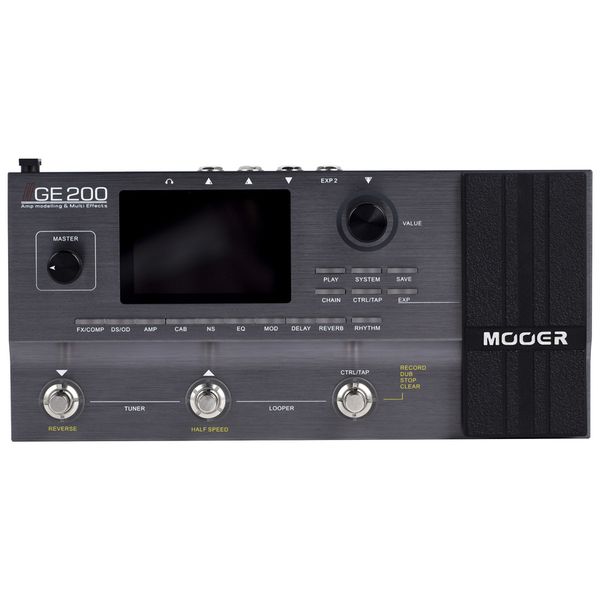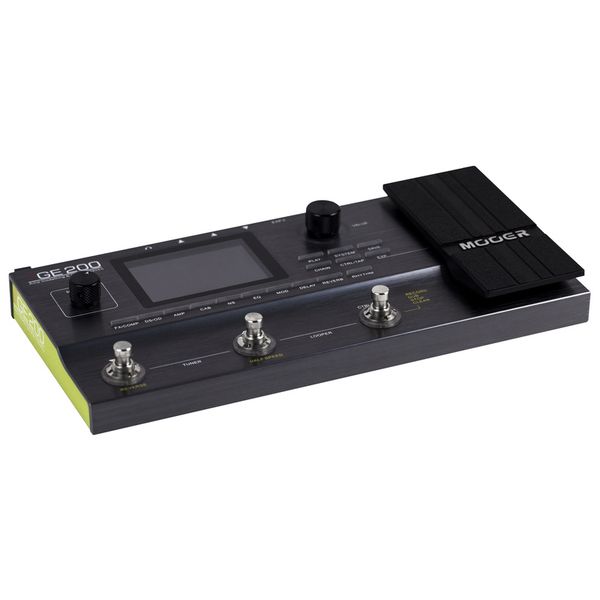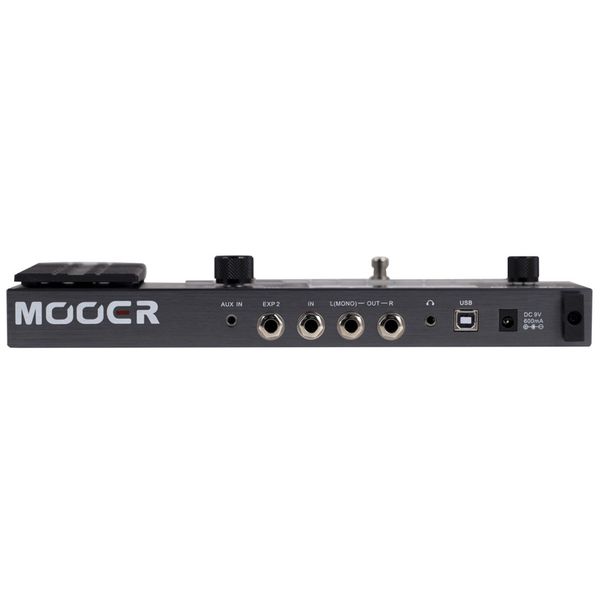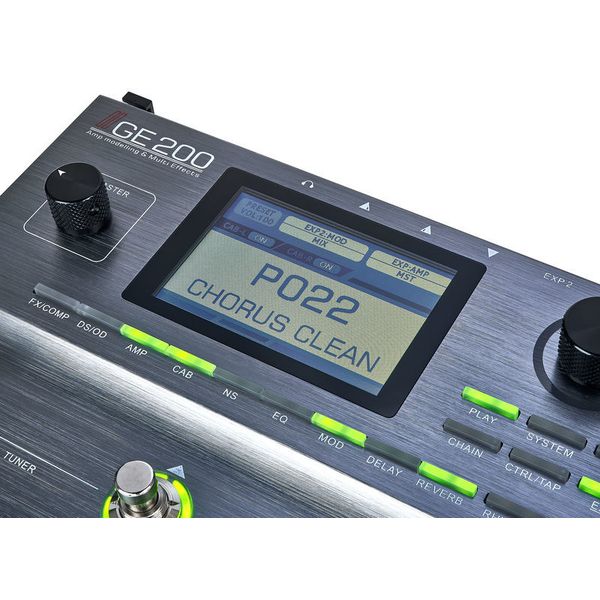The Moer GE200 is a very interesting little piece of gear. Coming in at its current price range puts it right up against a number of well known competitor products, with Moer being one of the less well known of the bunch. Right out of the gate, the presets actually sounds pretty good, which is somewhat of a rarity with amp modellers in this range. Having used a number of similar products, I can say the Moer actually fares very well in comparison.
Compared to something like the Line 6 POD HD range, amp models have a more realistic punch to them. Hvaing the freedom to load in your own impulse response really does completely change the value of the Moer. The ability to import custom impulse responses in the cab block section essentially allows you to achieve almost any sound and that is somewhat of a game changer in this price range. Further to this, the Moer has two outputs, which can be routed with diffent cab settings. So for example, were you to play live, rather than have the venue mic up your cab (and do a terrible job!), you can send your complete signal in to the front of house, and have the same guitar chain with the can block bypassed sent in to the fx loop of your amp.
Pros
- Incrdible value for money
While there are plenty of competitor prducts, the majority of them (at least in hardware form), are double the price of this unit!
- Flexible Signal Chain
The Moer allows you to move around the order of the blocks in your signal chain. So if you want a chorus after your amp, instead of before it, no problem!
- Good Number of Amp Models
The models you'll find on this unit tend to be based on all the usual suspects (Mesa, Peavey, Engl), and honestly, they sound pretty good right off the bat. Plenty of low end punch with high end clarity that is often completely lacking in less expensive amp modellers. If like me, you plan on using your own custom IR's and already have guitar sounds you;re looking to recreate, chances are you'll only ever use a couple of amp models. But, if you're planning building lots of different and unique guitar sounds, you'll rewally appreciate what the Moer has to offer in this regard.
- Excellent Build Quality
The Moer feels absolutely rock solid in terms of build. The body is all completely metal (with a brushed finish on top that looks really nice). Buttons feels durable, the control knobs feel sturdy, foot switches feel like they'll last, and the expression pedal has increibly smooth action. Very impressed with this aspect of the Moer.
- Impulse Resonse Import Functionality
Seriously, if ever there was a selling point of this product, this would be it. For those who don't really understand what an impulse response is, it's essentially a very short WAV file that contains extremely detailed EQ information. Theoreticly, this would allow you to replicate almost any amp sound, all in the Moer. The flip side of this is that while you can copy the sonic snapshot of one sound and apply it to another, that doesnt mean the dynamics of the sound will match the original.
Beyond guitar sounds though, there would be nothing to stop you sending an external mic pre in to the Moer and using the IR loading fuctionality to emulate sound of different microphones (It works, I've done it). Vocalist performing live and want to control the effects on your vocals? no problem. The Moer could easily do this so long as you also have a small portable mic pre amp.
- Surprising number of effects
The effects are all of the usual things you would need in your guitar rig (and more). Noise gates, compressors, reverbs, delays. There are enough effects here to build amost any sound you would ever want to.
Cons
- Limited effect options
So, while the effects are impressive in number, the way they work in the different blocks isnt very flexible. Effect chain blocks are fixed to a single function. For example, if like me, you never use any of the modulation effects, that block essentially goes to waste. What would be far more logical would be that you should be able to swap the function of that block for something else that is of more use to you, like a second noise gate. with the Line 6 POD HD's, you get to decide what each block is, so this is definately an area where the Moer falls down. There is certainly processing power to consider, but I'd much rather sacrifice the reverb, delay and modualtion blocks for more tone shaping functionality.
- Limited Gain Staging Options
An extremely important part of getting the dynamics right in your guitar sound is having control over the gain staging from block to block, but the Moer only offers this in a limited capacity. for example, one very useful feature is that you can set the input signal of your guitar, which is excellent to be able to do, but you're doing this before the noise gate, and so you're essentially introducing louder signal interference should you choose to use the input gain control. what would be far more logical, would be to have a volume control on each block, that way you arent introducing extra noise at the start of your signal chain, but you can still send a hot signal in to the amp block.
There is no reason that this couldnt be fixed via a software update.
- Incomplete software solutions
This is a fairly big issue. First off, there is no GE200 controller software for the Mac. Apparently, it's in development, but why has it not already been completed and why was the product released without the appropriate software to accompany it?! Not the biggest issue in the world though, because there is an IR importer for Mac, but it only works on High Sierra....
So, should you want to use the desktop editor to the Moer, you need to connect to a windows machine (for now), but that's not all. Before you can connect to the editor you need to update the firmware, which it doesnt actually tell you how to do, You get a little message saying you need to enter uopdate mode (or something along those lines), but there is no documentation included in the box to tell you how to put the unit in to this mode. After having found a video on youtube that I'm quite certain was in malaysian, I worked out that the way you put the device in to update mode is to turn off the unit, hold down the tuner switch and then turn the unit back on. This will allow the software updates to be applied.
Once you actually get in to the editor software, visually it's a bit of a mess and looks pretty cobbled together. A far cry from many of the sofware soltions to amp modelling we see these days. The main thing to take away is that once you get everything set up, it does work. Although, editing patches on the unit itself is more inuative.
- No On/Off Button
This is something I really cannot understand; There is no on/off switch. Essentially, as soon as the unit is plugged in, it is on, and to turn it off, you either have to pull the cable from the back or unplug it. Absolutely bizzare and annoying.
- Limited Amp Control
while Moer have done a good job of making the different amps sound and feel unique, you have pretty munch a low, mid, high and master output control for each amp, Very reminiscent of the old Pod Farm amp modelling days. Moer really could have and should have broken these down a little bit more though. Even just a low mids control would have been appreciated.
Who is the Moer GE200 for?
Despite the price and what the unit's size may suggest, with a little bit of know how, you'll be able to get almost any guitar sound from this unit, and the IR loader functionality is extremely valuable. This unit would be ideal for bedroom guitarists, live performers, small home recording studios or even bigger professional studios.
Let's face it, no one is going to be trading in their Axe-FX, Kemper or Helix for the Moer, but make no mistake, this is a professional piece of kit that is well worth the price, even if the software to accompany it, seems like an afterthought.
Also, Thomann, you're sending out the wrong adapter with this unit! The plug adapter you send can only fit a very small European plug, where as the adapter you actually need is for a much wider European plug.















